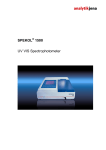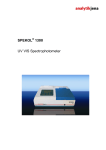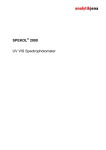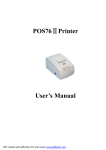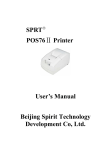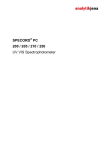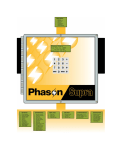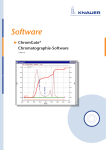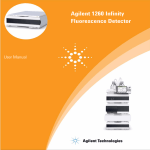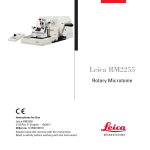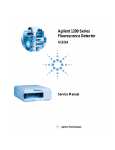Download TABLE OF CONTENTS:
Transcript
Contents Contents ® 1 Introduction .............................................................................. 3 1.1 Warning and safety labels on SPEKOL 1500...................................................3 1.2 Notes on the User's Manual .............................................................................4 2 Safety notes.............................................................................. 5 3 Technical data .......................................................................... 7 4 Unpacking instruction ............................................................. 9 4.1 Installation and transport conditions .................................................................9 4.2 Unpacking instruction .....................................................................................10 5 Design of the SPEKOL 1500 ................................................. 11 6 Maintenance ........................................................................... 13 6.1 Cleaning .........................................................................................................13 6.2 Replacing fuses..............................................................................................13 6.3 Replacing Halogen lamp ................................................................................14 6.4 Replacing Deuterium lamp .............................................................................15 7 Accessory............................................................................... 17 7.1 Manual 4 cell changer ....................................................................................17 7.2 Adjustable cell holder .....................................................................................17 7.3 Round cell holder ...........................................................................................18 7.4 Extension of sample compartment .................................................................18 7.5 Flow-through unit............................................................................................19 7.6 Thermostatted cell holder...............................................................................19 7.7 Thermostatted 3 cell manual changer ............................................................19 7.8 Printer.............................................................................................................20 8 Display and Buttons of SPEKOL 1500 ................................. 21 9 Software function................................................................... 23 9.1 Photometric mode ..........................................................................................23 9.2 Quantitative measurement .............................................................................24 9.3 Wavelength scan............................................................................................26 9.4 Kinetic Analysis ..............................................................................................27 9.5 Multi- Wavelength Measurement....................................................................28 9.6 DNA/ Protein measurement ...........................................................................28 9.7 System setup .................................................................................................29 User’s manual SPEKOL 1500 Analytik Jena AG Edition 07/2008 1 Contents 2 9.8 System positioning .........................................................................................30 9.9 Lights and A/D Conversion.............................................................................30 9.10 Connect to PC ................................................................................................31 10 Disposal .................................................................................. 33 Edition 07/2008 ® User’s manual SPEKOL 1500 Analytik Jena AG Introduction 1 Introduction The SPEKOL® 1500 is a single beam spectrophotometer. The instrument is compact, easy-to-use, and rugged. The large sample compartment accepts various accessories and cell from 10mm to 100mm path length. The built-in RS-232 serial interface enables the instrument to be connected to a printer. ® The SPEKOL 1500 is ideal to use in a clinical laboratory, biochemical laboratory, petrol chemical laboratory, environmental protection and various fields of quality control. This user′s manual provides the description of the SPEKOL® 1500, a list of main specifications and available accessories. After carefully unpacking the content, check the materials against the packing list to ensure that you have received everything in good condition. If some parts are missing, damaged or have any other defects, please contact your dealer or the sales representative immediately. 1.1 Warning and safety labels on SPEKOL 1500 The following warning and safety labels are located on the SPEKOL® 1500: Caution! Hazardous area. Do not remove this cover under any circumstances. Trained service people only. No serviceable components inside. Select the right voltage. Disconnect the power cable before opening the device cover or replacing fuses! ® User’s manual SPEKOL 1500 Analytik Jena AG Edition 07/2008 3 Introduction 1.2 Notes on the User's Manual In this manual, the following symbols are used to refer you to warnings and notes: Warning! Warning messages alert you to a specific procedure or practice which, if not followed correctly, could cause personal injury. Caution! Caution messages refer you to procedures which, if not observed, could result in damage to the equipment. Caution! Dangerous electric voltage! Caution! Emission of UV radiation! Disconnect power cable! Note This note must be followed to obtain correct measurement results. The following symbols are used: → Cross-reference: Refers to another section/illustration of the manual. For easier navigation within the manual, the manual uses the following system: 4 • Chapters and illustrations are numbered consecutively. • Every illustration has its own caption. • Steps of operation are numbered. • Cross-references are marked by an arrow (e.g. →Notes on the User's Manual p.3) Edition 07/2008 ® User’s manual SPEKOL 1500 Analytik Jena AG Safety notes 2 Safety notes For your personal safety and for a trouble-free operation, carefully read this chapter before starting the SPEKOL® 1500. Observe all safety notes given in this manual and all messages and notes displayed by the control software on the screen. In addition, observe the safety notes for system components of other manufacturers (e.g. PC, printer) supplied together with the device. In particular, you should also observe the safety notes given on the labels and the information on the use, storage and disposal of reagents, reaction cells and the notes on the package inserts of test kits. Intended use! ® The SPEKOL 1500, including original accessories, may only be used for the applications described in this manual. The manufacturer cannot assume any liability for any other application, including that of individual modules or single parts. This also applies to all service or repair work that is not carried out by authorized service personnel. All warranty claims shall be forfeited. Local safety regulations! Observe the local safety regulations relevant to the operation of the device (e.g. laborsafety regulations, regulations for the prevention of and protection against accidents). References to possible risks given in this manual do not replace the relevant labor-safety regulations that are to be followed. Personnel! ® The SPEKOL 1500 may only be operated by appropriately qualified and trained personnel. For that, the knowledge of the information provided by this manual is indispensable and taken for granted. Emergency stop! ® In the case of emergency, disconnect the SPEKOL 1500 and its components from line power by removing the power plug from the power outlet. Caution! This procedure involves the risk of data loss and damage to the operating system! Electric shocks! ® The SPEKOL 1500 is electrically powered. At several parts inside the system, extremely hazardous electrical voltages are accessible! To ensure Protection Class I (protective earth connection) of the device, connect the power plug of the device only to a power outlet with protective earth conductor. The protective effect must not be undone by the use of an extension cable without protective earth conductor. Before opening the device or removing any device covers, disconnect the power cable! ® User’s manual SPEKOL 1500 Analytik Jena AG Edition 07/2008 5 Safety notes Before connecting the SPEKOL® 1500 to the power outlet, make sure the line voltage supplied agrees with the operating voltage specified on the rating plate at the rear panel of the device. Operation of the device with any other operating voltage than that specified may result in the destruction of the device. Only use fuses of the specified type. Do not operate the device in explosion-risk rooms! UV radiation! Never look directly or indirectly, e.g. via a mirror, into the radiation emitted by the lamp to avoid the risk of getting conjunctivitis! Therefore, switch off the lamp for lamp replacement! Lamp damage! Do not grasp functioning halogen and deuterium lamps on their glass bulbs. Contamination on the bulb affects the radiation properties of the lamps. Especially protect the beam-exit window of the deuterium lamp. Risk of burns The lamp housing will heat up when lamps are operating. Contact with hot surfaces may cause burns. Before exchanging a lamp, please switch of the SPEKOL®1500, unplug the divice and wait until the lamps cooled down. Accumulation of heat Heat accumulation might result in overheating and faults on the device. ® Make sure not to cover the ventilation slots of the SPEKOL 1500! ® Before you switch on the SPEKOL 1500, remove its dust cover! Handling liquids ® Take care to ensure that no liquids can enter the SPEKOL 1500 to avoid any damage to the device. Risk of corrosion Do not set up the device in the vicinity of aggressive vapors, e.g. strongly corrosive acid or caustic vapors! The vapors might corrode the connections, mechanical and optical components of the device. Avoid exposing the sample compartment to strongly corrosive substances! For the analysis of such samples, use vapor-tight stoppered cells. After the measurement, do not leave the samples unnecessarily long in the sample compartment of the device! 6 Edition 07/2008 ® User’s manual SPEKOL 1500 Analytik Jena AG Technical data 3 Technical data ® Model SPEKOL® 1500 Optical System Littrow type, single beam, grating system 1200 Line/mm Spectral Slit width 2 nm Wavelength Range 190 to 1100 nm Wavelength Accuracy ± 2 nm Repeatability 1 nm Stray Radiant Energy ≤ 0.3 %T at 220 nm and 340nm Photometric Range 0 %T to 125.0 %T -0,1 A to 3 A 0 C to 9999 C Stability ± 0.002 A/hr (at 500 nm after 1 hour warm up) Photometric Accuracy ± 0.01 A Power Requirement 115 V / 230 V (adjustable) Frequency 50 to 60Hz Line fuses 2x T 4 AH Temperature working range +15°C to +35°C Humidity working range < 85% Size (W x D x H) 465 mm (18.3’) × 365 mm (14.3’) × 175 mm (6.9’) Weight 11.5 kg User’s manual SPEKOL 1500 Analytik Jena AG Edition 07/2008 7 Technical data 8 Edition 07/2008 ® User’s manual SPEKOL 1500 Analytik Jena AG Unpacking instruction Installation and transport conditions 4 Unpacking instruction 4.1 Installation and transport conditions Installation conditions Considering the dimensions of the SPEKOL ® 1500 and a clearance of approximately 100 mm to the sides and the front, the device needs a bench space of at least 665 x 565 mm. Caution! Do not cover the ventilation slots of the device! Do not place any objects on the device! Do not operate the device in explosion-risk rooms! Keep aggressive vapors, e.g. strongly corrosive acid or caustic vapors away from the vicinity of the device. The installation site of the SPEKOL® 1500 must meet the following requirements: • The place should be free of draft, dust, corrosive vapors as well as vibrations. • ® Do not set up the SPEKOL 1500 near electromagnetic fields (e.g. of motors). • Avoid dripping or splashing water near the instrument. • Do not expose the device to direct sunlight or the radiation of heaters. • Temperature range: + 15 ... + 35 °C • Humidity: up to 85 % (at + 30 °C) Conditions for storage and transport For transport and storage, the following ambient conditions must be complied with: ® User’s manual SPEKOL 1500 Analytik Jena AG • Temperature range in transport: -40...+70 °C • Relative humidity in transport: Edition 07/2008 up to 95 % 9 Unpacking instruction Unpacking instruction 4.2 Unpacking instruction Observe correct position of device! ® Move the SPEKOL 1500 only in upright position (observe label on transport case). Do not turn the device upside down. Electric shock Before connecting the SPEKOL® 1500 and the PC to line power, make sure the available line voltage agrees with the operating voltage specified on the type labels. Operation of the devices on line voltages other than the specified operating voltage may result in their destruction. 1. Unpack the contents carefully and check the materials. 2. Remove any obstructions or materials that could hinder the flow of air under and around the instrument vibration. 3. Select the right voltage. 4. Plug the power cord into an outlet. 5. Make sure that the first position of the cell changer is set. Remove anything in the sample compartment interfering with the light beam. 6. Turn on the instrument. A self test starts automatically. Caution Please allow the instrument to warm up for 20 minutes before taking any readings. Your SPEKOL® 1500 is now ready for operation. 10 Edition 07/2008 ® User’s manual SPEKOL 1500 Analytik Jena AG Design of the SPEKOL 1500 5 Design of the SPEKOL 1500 1 2 3 1 Display and Button display of data’s and control buttons for use of the internal software function 2 Sample compartment to insert accessories and sample cells 3 Cell selector arm of the Cell changer to change the position of the manual cell changer Fig. 1 SPEKOL® 1500 front side Note Pay attention that the cover of the sample compartment must be closed during the measurements. 4 Printer connection 5 RS 232 Interface Fig. 2 ® User’s manual SPEKOL 1500 Analytik Jena AG SPEKOL® 1500 right side Edition 07/2008 11 Design of the SPEKOL 1500 6 Power cable socket 7 Printer power connection power cable socket from the printer 8 Fuse holder 9 Voltage selection to select the voltage between 220 and 110 V 10 Power switch Fig. 3 12 SPEKOL® 1500 back side Edition 07/2008 ® User’s manual SPEKOL 1500 Analytik Jena AG Maintenance Cleaning 6 Maintenance This SPEKOL® 1500 spectrophotometer has been designed to be durable and reliable. Therefore, the routine maintenance of the instrument is minimal. However, you will need to clean spillings or to replace the lamp or you may want check the wavelength calibration and photometric linearity to verify the instrument′s performance. The manufacturer recommends only authorized service representatives to perform procedures requiring removal of the instrument′s cover and replacement of electrical components. To protect both of yourself and your instrument, be sure to contact the authorized service representative to perform any service procedure, when you do not feel comfortable performing. 6.1 Cleaning If sample substance was spilled in the sample compartment or accessory, instantly wipe it up using tissue paper. For cleaning the device cover from dust or spillings, please use a soft cloth and a commercial neutral cleanser. Do not expose SPEKOL® 1500 to corrosive atmosphere. 6.2 Replacing fuses If the line fuses are defective, you can change them yourself. Risk of electric shock! ® Before changing the fuses, make sure to switch the SPEKOL 1500 off with the power switch and disconnect the power cable from the power input connector of the device. 1. Remove the power cable from the SPEKOL® 1500. 2. Open the bayonet connections of the fuse holders (→Fig. 3 p.12) by turning to the left using a screwdriver. The fuseholder jumps up a little. 3. Replace the defective line fuses. Make sure to use only the following fuse types: • ® T 4 AH. 4. Re-insert fuse holder and lock the bayonet connection. 5. Reconnect the power cable to the power input connector of the SPEKOL® 1500 and the power outlet. 6. Switch the SPEKOL® 1500 on again. User’s manual SPEKOL 1500 Analytik Jena AG Edition 07/2008 13 Maintenance Replacing Halogen lamp 6.3 Replacing Halogen lamp Electric shock! Before changing the halogen lamp, make sure to switch the device off with the power switch. Caution: Risk of burns! Allow the halogen lamp to cool down to avoid the risk of burns! Caution: Eye injury! Never look into the lighting lamp as the radiation may cause eye injury! Caution! Do not touch the glass bulb of the lamp to avoid any contamination affecting its performance! 7. Turn the power off and unplug the instrument. 8. Put all samples and not fixed elements out of the sample compartment. 9. Place the SPEKOL 1500 carefully on a soft underlay on the top side of the device so that you can access the underside. Fig. 4 Lamp house cover on the under side of SPEKOL ® 10. Remove the two screws (11) and the lamp house cover (12) on the underside of the instrument. Fig. 5 14 ® Lamp compartment of SPEKOL , opened Edition 07/2008 ® User’s manual SPEKOL 1500 Analytik Jena AG Maintenance Replacing Deuterium lamp 11. Unscrew the holder of the halogen lamp (14) and take the holder with the halogen lamp out of the device. Fig. 6 SPEKOL® 1500 holder of the halogen lamp 12. Remove the lamp (16) from lamp holder 13. Replace the new lamp carefully in the holder. Caution Do not handle Halogen lamp with bare fingers. Use a piece of tissue or cloth when handling the lamp. The oil from your fingers can cause the lamp to burn out prematurely! 14. Replace and fix the holder with the new halogen lamp in the device 15. Close the cover of the lamp house using the 2 screws. 16. Replace the device with the top side on top. 6.4 Replacing Deuterium lamp Risk of electric shock! Before changing the deuterium lamp, make sure to switch the device off with the power switch. Caution: Risk of burns! Allow the deuterium lamp to cool down to avoid the risk of burns! Emitted UV radiation! Never look directly or indirectly, e.g. via a mirror, into the radiation emitted by the lamp to avoid the risk of getting conjunctivitis! Dirt on beam exit window! Do not touch the glass bulb of the new deuterium lamp. Particularly avoid contamination on the quartz glass beam exit window! If you touched the glass bulb with your fingers, wipe the fingerprints off with a clean, lintfree cloth and pure alcohol. The performance of the lamp will deteriorate by contamination. ® 1. Turn off the power and unplug the instrument 2. Put all samples and not fixed elements out of the sample compartment User’s manual SPEKOL 1500 Analytik Jena AG Edition 07/2008 15 Maintenance Replacing Deuterium lamp 3. Place the SPEKOL 1500 carefully on a soft underlay on the top side of the device so that you can access the underside 4. Remove the two screws (11) and the lamp house cover (12) on the underside of the instrument 5. Unscrew the 2 screws of the deuterium lamp (13), disconnect the electronic plug connection (15) and take the deuterium lamp out of the device Do not handle Deuterium lamp with bare fingers. Use a piece of tissue or cloth when handling the lamp. The oil from your fingers can cause the lamp to burn out prematurely! 16 6. Replace the new deuterium lamp and fix it with the screw 7. Close the cover of the lamp house using the 2 screws. 8. Replace the device with the top side on top. Edition 07/2008 ® User’s manual SPEKOL 1500 Analytik Jena AG Accessory 7 Accessory For the installation of accessory use the two screws on the bottom of the sample compartment. 7.1 Manual 4 cell changer The standard configuration is a 4 cell changer for 1 cm cells. As an option there are also 4 cell changers for cells with 50 and 100 mm path length available. Fig. 7 Manual 4 cell changer Use the cell selector arm (→ Fig. 1, p.11) of the manual cell changer to set the position of the manual cell changer. Position 5 Sample 3 Position 4 Sample 2 Position 3 Sample 1 Position 2 0%T Position 1 Reference Fig. 8 7.2 Positiond of the 4 cell changer Adjustable cell holder Micro cells and ultra micro cells have the standard outside width of 12.5 mm, but a reduced inside width or filling aperture of 1 to 4 mm. This requires accurate alignment of the cell in the light beam. The adjustable cell holder can be used for cells with an aperture height of 8,5 mm. ® User’s manual SPEKOL 1500 Analytik Jena AG Edition 07/2008 17 Accessory Fig. 9 SPEKOL® 1500 adjustable cell holder 1. Insert the adjustable cell holder in the sample compartment with screw 1 to the back site. 2. Use the screw 1 to adjust the cell horizontal to the light beam and screw 2 to adjust the cell vertical to the light beam. The cell has the optimal position if the highest transmittance is reached. Together with the extension of sample compartment (8.4) and an external pump, also flow cells can be used with this cell holder. 7.3 Round cell holder This special cell holder can be used for round cell of standard test kits. Cells with a diameter up to 16 mm and a height up to 110 mm can be used. 7.4 Extension of sample compartment This extension is an attachment for tube openings that allows the use of thermostatted ® cell holders. It can easily be adapted to the SPEKOL 1500 sample compartment. Fig. 10 18 SPEKOL® 1500 extension of sample compartment Edition 07/2008 ® User’s manual SPEKOL 1500 Analytik Jena AG Accessory 7.5 Flow-through unit The flow-through unit requires the adjustable cell holder, the extension of sample compartment and a pump system. 1. Insert the adjustable cell holder into the sample compartment. 2. Mount the extension on the border of the sample compartment. 3. Slide the obliquely cut end of PTFE sipping hose over the hose stern on the cell body (marked with an arrow). Put the silicon sleeve of the sipping hose over the stern in order to make the connection leak proof. Slide the other hose end through one of the tube opening. 4. Slide the pump hose through the second tube opening. Connect the second cell stern with the pump system. 5. Insert the flow-through cell in the cell holder and adjust the cell (→ section "Adjustable cell holder" on p.17.). 6. Start the flow-through operation. 7. Stop the flow-through operation. Read the measurement values. The carry-over from sample to sample can be kept low, if an ample portion of the sample is used for rinsing the cell before a measurement. 7.6 Thermostatted cell holder The water- thermostatted cell holder can be used for temperature dependent measurement of samples. It is possible to connect the thermostatted cell holder to an external thermostat. This accessory is available for cells with 10mm or with 50 mm pathlength. 7.7 Thermostatted 3 cell manual changer The 3 cell water jacketed manual changer is available for cell with 10mm pathlength. Use the cell selector arm (→ Fig. 1, p.11) of the manual cell changer to set the position of the manual cell changer. Position 4 Sample 2 Position 3 Sample 1 Position 2 0%T Position 1 Reference Fig. 11 ® User’s manual SPEKOL 1500 Analytik Jena AG Position of 3 cell changer Edition 07/2008 19 Accessory 7.8 20 Printer 1. To install the printer to the SPEKOL® 1500 switch the device off. 2. plug the electrical connections into the RS 232 at the right side (→Fig. 2, 4 p.11) and the printer power connection at the back side of the device (→Fig. 3, 6 p.12). 3. Restart the instrument. Edition 07/2008 ® User’s manual SPEKOL 1500 Analytik Jena AG Display and Buttons of SPEKOL 1500 8 Display and Buttons of SPEKOL 1500 Fig. 12 Display and buttons of SPEKOL® 1500 Display The digital readout displays the data of transmittance, absorbance and concentration and scanned spectra ↑↓← → Setup X\Y- axis, move up\down\left\right, or choose the item. (When inputting a letter, a switch between capital and small letters can be made using ↑ or ↓ ) [ESC] Exit, return to the last operation, or cancel the operation [Print] Print [Cell] Not valid for SPEKOL® 1500 [Set WL] Set a wavelength 100 % T BASELINE Adjust 100%T, or adjust blank, or calibrate baseline. MEASURE START Start measurement. [CE] Delete (delete input, cancel edit, delete measured data, delete files) [Ent] Enter [Save] Save file [Open] Open file [F1], [F2], [F3], [F4] Keyboard shortcuts [0*], [1#], Character key [2ABC]… [9WXYZ], [._ ], [- / ] ® User’s manual SPEKOL 1500 Analytik Jena AG Edition 07/2008 21 Display and Buttons of SPEKOL 1500 22 Edition 07/2008 ® User’s manual SPEKOL 1500 Analytik Jena AG Software function Photometric mode 9 Software function After the instrument was switched on, a self-testing procedure will be performed. When this has been finished, the beeper will ring three times and the system will enter the main interface: 1 Photometric mode 2 Quantitative measurement 3 Wavelength scan 4 Kinetics analysis 5 Multi- Wavelength measurement 6 DNA Protein measurement 7 System setup 8 System positioning 9 Lights and A/D conversion 10 Connect to PC In order to select the operation mode, either press a suitable number key to enter the interface, or use the cursor keys ↓ or ↑. Now press [Ent.] to enter the interface. When the instrument is restarted, the system will remember the last parameters automatically. 9.1 Photometric mode In this mode, basic absorbance and transmittance measurements as well as concentration measurements can be performed. To enter the mode, please strike either [1 #] or use the cursor keys ↓ or ↑ and [Ent]. There are four function shortcuts: Unit [F1], Mode [F2], K Factor [F3], Standard [F4]. Unit: Strike [F1] to enter the setup. After appearance of the message “Please select unit:”, strike ↓ or ↑. The following units can be selected: mg/L, g/L, ng/g, µg/g, %, IU, mM/L, M/L, µg/ml, mg/ml, other. In case “other” was selected, please confirm by striking [Ent]. Follow the message “Please input self defined unit:” and confirm by striking [Ent]. Mode: Strike [F2]. Follow the command “please select mode:” by striking ↓ or ↑ Abs, T%, or Conc. can be selected. Please confirm your input striking [Ent]. K Factor: Strike [F3]. After “Please input Factor: ” was displayed, a value between 0.000 and 9999 can be entered. Standard: Strike [F4]. Follow the command “Please input Conc. of standard: ”, input a value between 0.000 and 9999 and confirm [Ent]. ® User’s manual SPEKOL 1500 Analytik Jena AG Edition 07/2008 23 Software function Quantitative measurement 9.1.1 Measurement in photometric mode Note Pay attention that the second step of the manual cell changer is only for reading 0%T. There are two steps between Position 1 and 2 of the manual cell changer. Choose cells with the same path length for all blanks, standards and samples of the analytical method you are using. For measurements below 325 nm use quartz cells. Glass or plastic cells are only usable above 325 nm. The liquid level must be at least 20 mm in a standard square cell. 1. Set the wavelength by striking [Set WL]. Follow the command “Please input wl:”, input the value and confirm [Ent]. The system will move to the entered wavelength. 2. Strike [F2] to select the mode. 3. When measuring T%, or Abs, put in the reference solution and tap 100%T BASELINE to adjust blank. 4. Put in the sample. The value is read out instantly. 5. To determine a concentration, strike [F1] and select a unit. Perform measurement of blank striking the key 9.2 100%T . BASELINE 6. Put in the sample. If the sample has a known K-factor, please strike [F3], and input your K-factor. The system will measure the absorbance, and the concentration is read out directly. 7. In case the K- factor of the sample is unknown, you have to use a standard first. Please strike [F4], input the standard concentration and confirm [Ent]. The system will measure the absorbance and calculate the K-factor (K = Conc./ Abs). Now, the sample can be measured. The concentration will be read out directly. Quantitative measurement To enter the mode, please strike either [2 ABC] or use the cursor keys ↓ or ↑ and [Ent]. In this mode, there are two operating states: Quantitative test and Standard calibration curve. The first operating state when entering the mode is Quantitative test. Quantitative measurements can be performed directly with known coefficients. Determination of concentration may also be calculated according to a standard calibration curve (see 10.2.1.). Two function shortcuts are accessible: Unit [F1], Fit Curve [F2]. Unit: Enter the setup tapping [F1]. After appearance of the message “Please select unit:”, strike ↓ or ↑. The following units can be selected: mg/L, g/L, ng/g, µg/g, %, IU, mM/L, M/L, µg/ml, mg/ml, other. In case “other” was selected, please confirm by striking [Ent]. Follow the message “Please input self defined unit:” and confirm by striking [Ent]. Fit curve: Strike [F2] to enter the standard curve operating state, begin the next setup. Four function shortcuts are available: Method [F1], Params [F2], Standard [F3], Show curve [F4]. 24 Edition 07/2008 ® User’s manual SPEKOL 1500 Analytik Jena AG Software function Quantitative measurement Method: Tap [F1] to enter the setup for Fit method. Using the cursor keys ↓ or ↑, one can choose between these methods: Linear fit through zero, Linear fit, Square fit, Cubic fit. Params: To modify coefficients, strike [F2]. With a selected method Linear fit through zero, the message “Input K1 =” would appear. Input the value and confirm [Ent]. Subsequently “Input r =” and confirm [Ent]. Having selected Cubic fit, the factors: K0, K1, K2, K3 need to be entered. For the other methods available, please proceed analogously. Standard: Strike [F3] to enter the standard setting. Follow the message “Edit the number… ” and confirm [Ent]. Now, “Input standard Conc.”and confirm [Ent]. Input further values accordingly. Tap [Esc] to end the setting. Show Curve: To display the standard curve after measurement has been completed, please strike [F4]. 1. Measurement in quantitative measurement mode 2. Strike [Set WL] The message “Correction method:” appears. Choose between the methods Single WL, 3 Points, Isoabsorbance using the cursor keys ↓ or ↑ and confirm [Ent]. 3. For setting a standard curve, please strike [F1] to select a unit and confirm [Ent]. 4. Strike [F2] to set the standard calibration curve. Tap [F1] to select the fit method and confirm [Ent]. Strike [F3] to enter the standard’s settings. Follow the message “Edit the number… ” and confirm [Ent]. Now, “Input standard Conc.”and confirm [Ent]. Input further values accordingly. Tap [Esc] to end the setting. 5. Performing the measurement: After having left the settings by striking [Esc], the message “Blank First…”, will appear. Put in the reference substance and strike 100%T . Now follow the message “Place Standard #1”and proceed BASELINE accordingly. After measurement has been completed, the corresponding equation will be displayed. Other fit methods can be chosen and the system will change the parameters accordingly. 6. Strike [F4] to view the curve. 7. To save the standard curve, strike [Save]. Follow the message “Please input file name” and confirm [Ent]. The file will be saved in “.STD” format. 8. After the standard curve has been recorded successfully, strike [Esc]. In order to determine a sample’s concentration, strike MEASURE . After the message START “Blank first…”, is displayed, put in the blank of sample and strike [Ent]. Now follow the message “Place sample” and strike MEASURE . The result is read out START instantly. Up to 100 values can be stored in the table. Should the data be saved, please strike [Save]. The file will be saved in “.QUA” format. ® User’s manual SPEKOL 1500 Analytik Jena AG Edition 07/2008 25 Software function Wavelength scan 9.3 Wavelength scan In this mode, absorbance or transmittance spectra can be recorded. It is possible to do a correlation analysis. To enter the mode, please strike either [3 DEF] or use the cursor keys ↓ or ↑ and [Ent]. There are the following function shortcuts: Setup [F1], Mode [F2], Search [F3]. Setup: Strike [F1] to enter the setup. Please note that the system scans from the maximum wavelength to the minimum wavelength. Enter a maximum wavelength when the message “Scan From” appears and confirm your entry. Now enter the minimum wavelength according to the message “Scan To” and confirm [Ent]. Next, choose Scan Step using the cursor keys ↓ or ↑ and confirm [Ent]. Input the Scan Speed analogously. Mode: Striking [F2] leads to the message “Please select mode”. With ↓ or ↑ display of Absorption (Abs) or Transmission (T%) can be selected. Search: After the scan has been completed, please strike [F3] to enter the search mode. The function shortcut: Threshold [F1] is active. Striking [F1] leads to “Please input peak height: ”. Confirm your input and press the key ↓ or ↑ to search a peak. Use the cursor keys ← or → to display ordinate values at selected wavelengths. 9.3.1 Measurement in mode Wavelength Scan 1. To set the scan parameters, please strike [F1]. Enter a maximum wavelength when the message “Scan From” appears and confirm your entry [Ent]. 2. Enter the minimum wavelength according to the message “Scan To” and confirm [Ent]. 3. Choose Scan Step using the cursor keys ↓ or ↑ and confirm [Ent]. Step width can be selected from 1 to 5.0 nm. Please note that the maximum number of data points per scan is 1001. 4. Select a Scan Speed using the cursor keys ↓ or ↑ and confirm [Ent]. The speeds Fast, Normal and Slow are available. 5. Strike the cursor keys ↑ or ↓ to set the Y-axis. Enter ordinate values for “min Y:” and confirm [Ent]. Proceed analogously with “max Y: ”. 6. Strike [F2] and select a scan mode (Abs or T%) using the cursor keys ↓ or ↑ and confirm [Ent]. 7. Put in the reference and strike 8. Put in the sample and strike 9. After a finished scan, the wavelength is set to the starting point. 100%T BASELINE to measure a calibration baseline. MEASURE . The spectrum is displayed instantly. START 10. To save your scans, strike [Save]. Follow the message “Please input File Name” and confirm [Ent]. The file will be saved in “.wav” format 11. To enter the peak search mode, please strike [F3]. The function shortcut: Threshold [F1] is active. Striking [F1] leads to “Please input peak height: ”. Confirm your input and press the key ↓ or ↑ to search a peak. Use the cursor keys ← or → to display ordinate values at selected wavelengths (above threshold). 26 Edition 07/2008 ® User’s manual SPEKOL 1500 Analytik Jena AG Software function Kinetic Analysis 9.4 Kinetic Analysis In this mode, time-dependent changes of absorption or transmittance can be recorded. It is possible to do a correlation analysis. To enter the mode, please strike either [4 GHI] or use the cursor keys ↓ or ↑ and [Ent]. There are the following function shortcuts: Setup [F1], Mode [F2], Process [F3] and Search [F4]. Setup: Please strike [F1]. Enter the total measuring time (s) and confirm [Ent]. “Input time interval” using the cursor keys ↓ or ↑ and confirm [Ent]. Mode: Striking [F2] leads to the message “please select mode”. Select between Absorption or Transmission using the cursor keys ↓ or ↑ and confirm [Ent]. Process: Calculates a I.U. value. Strike [F3]. Enter a Begin Time, an End time, and a Factor and confirm [Ent], respectively. The result is read out instantly. Search: Strike [F4] to enter the search mode. Tap ← or → to move along the abscissa from data point to data point. 9.4.1 Measurement in mode Kinetic Analysis 1. Strike [Set WL], follow the message “Please input wl:” and confirm [Ent]. The system will now move to the selected wavelength, and adjust blank automatically. 2. Enter the setup striking [F1], enter the total measuring time (s) and confirm [Ent]. 3. “Input time interval” using the cursor keys ↓ or ↑ and confirm [Ent]. 4. Striking the cursor keys ↑ or ↓ leads to the message “Min Y:”. Enter a value and confirm [Ent] and proceed analogously with “Max Y: 5. Select absorption or transmission striking [F2]. 6. Put in the reference and strike 7. Put in the sample, strike 8. To save data, tap [Save]. Follow the message “Please input File Name”and confirm [Ent]. The file will be saved in “.kin” format 9. To calculate I.U. values, please strike [F3] and input Begin Time, End Time, and a Factor and confirm [Ent], respectively. The result is read out instantly and may be printed. 100%T BASELINE to adjust blank. MEASURE . The graph is shown instantaneously. START Note The maximum of total time is 30000s, and the maximum number of data points should not exeed 4000. ® User’s manual SPEKOL 1500 Analytik Jena AG Edition 07/2008 27 Software function Multi- Wavelength Measurement 9.5 Multi- Wavelength Measurement Multi-Wavelength measurement is suited for checking the sample’s absorbance or transmittance at several wavelengths at one time. Please enter the mode by either striking [5 JKL] or use of the cursor keys ↓ or ↑ and confirm [Ent]. There are two function shortcuts available: WL Setup [F1], Mode [F2]. WL Setup: Strike [F1] to enter the setup. Follow the message “Edit the number… ” and confirm [Ent]. Now, “Please input wl: ” and confirm [Ent]. Please input further values accordingly. Strike [Esc] to end the setting. Mode: Strike [F2]. Now, “please select mode” using the cursor keys ↓ or ↑ to select Abs or T%. Confirm striking [Ent]. 9.5.1 Measurement in mode Multi- Wavelength Measurement 1. To set parameters, please strike [F1]. Follow the message “Edit the number… ” and confirm [Ent]. Now, “Please input wl: ” and confirm [Ent]. Please input further values accordingly. Strike [Esc] to end the setting. 2. Select the display mode [F2]. 3. Put in your reference and strike 4. Place the sample and strike 100%T . BASELINE MEASURE START to measure. (Note: During measurement process the system will follow the sequence wavelengths were set. When a measurement process is completed, the wavelength is reset to the first wavelength .) 5. 9.6 To save your data, please strike [Save]. Follow the message “Please input File Name:” and confirm [Ent]. The file will be saved in “.mul” format. DNA/ Protein measurement This mode is suited for quantitative analyses and purity testing of DNA or proteins according to the DNA and protein’s special absorbance in the UV range. . Please enter the mode by either striking [6 MNO] or use of the cursor keys ↓ or ↑ and confirm [Ent]. Two function shortcuts are active: Mode [F1], Unit [F2]. Mode: Strike [F1]. The message “Measurement: ” appears. Using the cursor keys ↓ or ↑ you can now select Absorbance difference 1 (260 and 280 nm) or Absorbance difference 2 (260 and 320 nm). Please confirm your choice [Ent]. After the message “With Reference” you can choose wether to use a reference or not. The reference wavelength is 320nm. Unit: Strike [F2]. Please follow the message “Please select unit”and strike ↓ or ↑. The following units are programmed: mg/L, g/L, ng/g, µg/g, %, IU, mM/L, M/L, µg/ml, mg/ml, other. If “other” was selected, please confirm striking [Ent]. Follow the message “Please input self defined unit:” and confirm striking [Ent]. 28 Edition 07/2008 ® User’s manual SPEKOL 1500 Analytik Jena AG Software function System setup 9.6.1 Measurement in DNA/Protein measurement mode 1. Strike [F1]. Choose measuring mode Absorbance difference 1 or Absorbance difference 2 and whether to measure a reference sample. 2. Strike [F2] to select a measuring unit. 3. If you agreed to carry out your analysis with reference measurement, put in the 100%T . BASELINE reference and strike 4. Place your sample and strike MEASURE . As soon as measurement is START completed, the result will be read out. 5. 9.7 To save your data, please strike [Save]. Follow the message “Please input File Name” and confirm [Ent]. The file will be saved in “.dna” format. System setup Please enter the mode by either striking [7 PQRS] or using the cursor keys ↓ or ↑ and confirm [Ent]. In order to select the operation mode, either press a suitable number key to enter the interface, or use the cursor keys ↓ or ↑. Now strike [Ent] to enter the interface. The following menu items are accessible: 1 Restore default settings 2 Beeper on/off 3 Select language 4 Printer setup 5 Format file system Restore default settings: This operation would reset the instrument to its original settings. Files are not formatted. Beeper on/off: If the beeper is activated, the icon of a loudspeaker is displayed. At the default state, the beeper is on. Select language: The message “Select Language: ” appears. With the cursor keys ↓ or ↑ you can select Chinese, English or German. : The message “Printer: ” is displayed. With the cursor keys ↓ or ↑, you can select from the following printers: SPRT SP _T, HP PCL (1 color cartridge), HP PCL (black mode) or SPRT SP _POS76II. Format file system: The display shows “Delete entire files, are you sure? ”. With the cursor keys ↓ or ↑, you may select Yes or No. If No was selected, the operation is cancelled. If Yes, all the files stored will be deleted. ® User’s manual SPEKOL 1500 Analytik Jena AG Edition 07/2008 29 Software function System positioning 9.8 System positioning Please enter the mode by either striking [8 TUV] or using the cursor keys ↓ or ↑ and confirm [Ent]. In order to select the operation mode, either press a suitable number key to enter the interface, or use the cursor keys ↓ or ↑. Now strike [Ent] to enter the interface. The following menu items are accessible: 1 Wavelength Calibration 2 Search the first filter 3 Change the filter 4 Set slit width 5 System calibration Wavelength calibration: Find the D2 lamp’s particular spectrum line at 656.1nmn to adjust precision of the instrument’s wavelength positioning. Search The First Filter, Change The Filter: This functions are not valid for the user. Set Slit Width: This function is not valid for SPEKOL 1500 System Calibration: Restores default settings, measures dark current and position of the light. At last, the position of D2 lamp’s particular spectrum line at 656.1nm checked by the system. 9.9 Lights and A/D Conversion Please enter the mode by either striking [9 WXYZ] or using the cursor keys ↓ or ↑and confirm [Ent]. In order to select the operation mode, either press a suitable number key to enter the interface, or use the cursor keys ↓ or ↑. Now strike [Ent] to enter the interface. The following menu items are accessible: 1 Switch On/Off D2 lamp 2 Switch On/Off W lamp 3 Change D2/ W switch point 4 Set amplifier 5 Set W lamp power Switch On/Off D2 or W Lamp: If the D2 or W lamp was already switched on, this procedure would switch it off. Operation state of the lamp is shown in the upper right corner of the display. If a lamp is switched on, “on” is displayed. Change D2/W Switch Point: Follow the message “Input the D2/W switch point:” and confirm [Ent]. The switch point may be set from 300 to 360nm. Set Amplifier, Set W Lamp Power: This function is not valid for the user. 30 Edition 07/2008 ® User’s manual SPEKOL 1500 Analytik Jena AG Software function Connect to PC 9.10 Connect to PC On operation, the display shows “Connecting to computer… ”. If this procedure was successful, the message “PC Connected… ” is displayed. To quit PC connection, please strike [Esc]. ® User’s manual SPEKOL 1500 Analytik Jena AG Edition 07/2008 31 Software function Connect to PC 32 Edition 07/2008 ® User’s manual SPEKOL 1500 Analytik Jena AG Disposal 10 Disposal ® The owner/operator of the SPEKOL 1500 must ensure to dispose of the waste material (samples) cropping up in the analyses in accordance with the relevant legal and local regulations. When the service life of the device is over, dispose of the device with its electronic components as electronic scrap observing the relevant regulations. ® User’s manual SPEKOL 1500 Analytik Jena AG Edition 07/2008 33

































